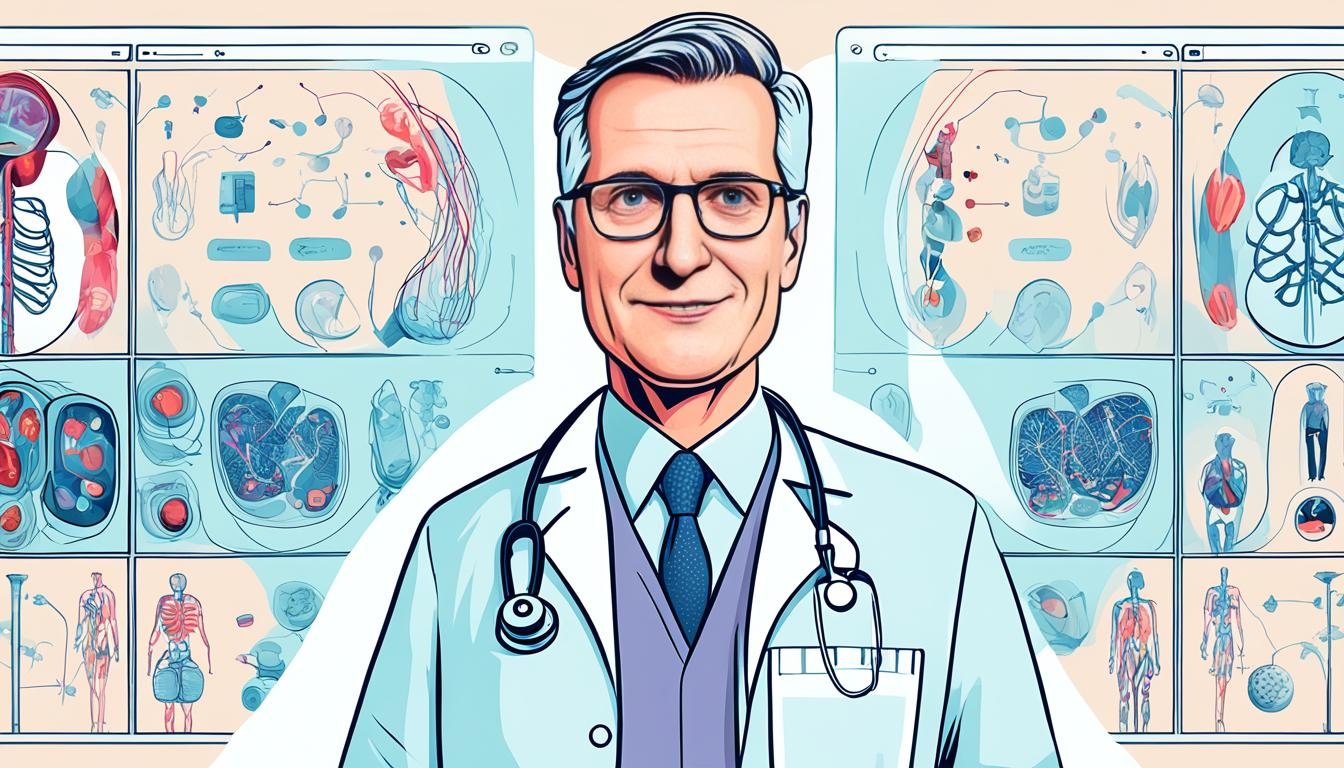The Role of AI in Medical Imaging and Radiology
Did you know that artificial intelligence (AI) is transforming the field of medical imaging and radiology? With the use of deep learning algorithms, AI-powered medical imaging tools have the potential to revolutionize diagnosis accuracy, personalized treatment options, and overall patient care.
AI technology brings numerous applications in medical imaging, including the analysis of complex patterns, quantitative evaluation of radiographic traits, detection of image modalities at different treatment stages, and identification of disease characteristics that may not be detectable by the human eye. These advancements are driving significant transformations in the way medical imaging is performed and interpreted, making it more efficient and effective than ever before.
Key Takeaways:
- AI is revolutionizing medical imaging and radiology with its deep learning algorithms.
- Applications of AI in medical imaging include pattern analysis, evaluation of radiographic traits, and disease identification.
- AI-powered medical imaging tools enhance accuracy, efficiency, and personalized treatment options.
- AI has the potential to transform the field and improve patient care significantly.
- The future of AI in medical imaging looks promising, with enhanced collaboration and integration into healthcare systems.
Challenges in Medical Imaging and Radiology
Despite the advancements in medical imaging, the field still faces several challenges and limitations that need to be addressed. Traditional imaging techniques, while valuable, have their own set of limitations in terms of accuracy and efficiency, which can result in inaccurate diagnoses and missed abnormalities. Healthcare providers also grapple with a significant backlog of imaging-related demands, particularly in the post-pandemic world where there is an urgent need to process a higher volume of imaging studies efficiently. There is a pressing requirement for improved speed and efficiency in imaging analysis and reporting to keep up with the increasing demands and deliver timely patient care.
AI-powered medical imaging analysis presents a promising solution to these challenges. By leveraging the power of artificial intelligence and deep learning algorithms, medical imaging analysis can provide decision support to healthcare professionals, improving the accuracy of diagnosis and efficiency of interpretation. AI algorithms can process vast amounts of imaging data quickly and accurately, helping reduce the workload on radiologists and other medical practitioners. This can lead to faster and more precise diagnoses, enabling prompt interventions and improved patient outcomes.
“The current limitations in traditional imaging techniques highlight the need for transformative solutions that can enhance accuracy and speed in medical imaging analysis.” – Dr. Jane Thompson, Radiologist
AI-powered medical imaging analysis not only addresses the challenges of accuracy and efficiency but also enhances the overall patient care experience. By automating routine tasks, AI algorithms free up time for medical practitioners to focus on personalized patient care and complex cases. Additionally, the implementation of AI capabilities in imaging analysis can help standardize reporting, ensuring consistent and comprehensive results across different healthcare institutions. This can facilitate better collaboration among healthcare professionals and improve the continuity of care for patients.
Taking a step further, the integration of AI-powered medical imaging solutions with electronic health records (EHR) systems can enable seamless information sharing and tracking of patient care. This integration enhances the ability to monitor disease progression, response to treatment, and the effectiveness of interventions, thereby enabling more personalized and efficient patient management.
Addressing the Backlog of Imaging-Related Demands
The backlog of imaging-related demands poses a significant challenge for healthcare providers and radiologists. This bottleneck can lead to delays in diagnosis, prolonged waiting times for patients, and increased stress on healthcare resources. AI-powered medical imaging analysis can help alleviate this challenge by streamlining the workflow and enabling faster turnaround times.
By automating routine tasks like image preprocessing and initial analysis, AI algorithms can significantly reduce the time required for radiologists to review each imaging study. This allows them to focus their expertise on complex cases and make critical decisions more efficiently. Furthermore, AI algorithms can prioritize urgent cases based on clinical information, ensuring that patients with potentially life-threatening conditions receive prompt attention.
To optimize the efficiency of imaging analysis and reporting, AI algorithms can also be trained to identify and flag abnormal findings that require further investigation. This assists radiologists in quickly identifying critical findings and expedites the overall diagnostic process.
The implementation of AI-powered medical imaging analysis brings a paradigm shift in the field, addressing the challenges associated with accuracy, efficiency, and the backlog of imaging-related demands. By harnessing the potential of artificial intelligence, healthcare providers can ensure faster and more accurate diagnoses, optimize patient care, and improve outcomes.
Use Cases of AI-Powered Medical Imaging
AI-powered medical imaging technology has proven to be incredibly versatile, offering valuable applications in a wide range of medical conditions. Let’s explore some of the key use cases where AI has made significant contributions:
Cardiovascular Conditions
AI-based medical imaging tools have demonstrated remarkable capabilities in the detection and analysis of cardiovascular conditions. These technologies assist in identifying critical factors such as left atrial enlargement and automating complex procedures like aortic valve analysis. By harnessing the power of AI, healthcare professionals can enhance their ability to diagnose and treat cardiovascular abnormalities effectively.
Neurological Abnormalities
The applications of AI in medical imaging extend to the field of neurology, offering valuable insights into neurological abnormalities. By utilizing AI algorithms in brain imaging, medical professionals can diagnose conditions like Alzheimer’s disease and identify neurological abnormalities such as amyotrophic lateral sclerosis (ALS). The integration of AI-powered technologies empowers neurologists to make accurate and timely diagnoses, leading to improved patient outcomes.
Cancer Screening
AI plays a pivotal role in cancer screening, particularly in the accurate identification of potential malignancies. In breast cancer screening, AI-powered medical imaging tools enable healthcare providers to detect microcalcifications in mammograms, assisting in the early diagnosis of breast cancer. This advanced technology helps reduce false-negative results and enhances the precision and efficiency of cancer screening processes.
Brain Tumors
The application of AI in medical imaging has greatly improved the classification and detection of brain tumors. AI-powered algorithms are trained to analyze brain images and identify tumor characteristics that may not be easily detectable through traditional imaging techniques alone. This enables healthcare professionals to make more accurate and informed decisions regarding treatment plans for patients with brain tumors, ultimately improving patient outcomes.
Fractures and Musculoskeletal Injuries
AI-powered medical imaging has also shown promise in the detection of fractures and musculoskeletal injuries that may be challenging to identify through traditional means. By leveraging advanced AI algorithms, healthcare professionals can enhance their ability to accurately diagnose fractures and assess the severity of musculoskeletal injuries. This aids in creating tailored treatment plans that promote optimal recovery for patients.
AI-powered medical imaging is continuously evolving, with new applications and advancements emerging regularly. These technologies bring unprecedented capabilities to the field of medical imaging, enabling healthcare professionals to provide more accurate diagnoses, personalized treatments, and improved patient care.
https://www.youtube.com/watch?v=rrhdHwMe1AY
| Medical Condition | Application of AI in Medical Imaging |
|---|---|
| Cardiovascular Conditions | Identification of left atrial enlargement and automation of aortic valve analysis. |
| Neurological Abnormalities | Diagnosis of Alzheimer’s disease and identification of neurological abnormalities like ALS. |
| Cancer Screening | Accurate identification of microcalcifications in breast cancer screening. |
| Brain Tumors | Improved classification and detection of brain tumors. |
| Fractures and Musculoskeletal Injuries | Enhanced detection and assessment of fractures and musculoskeletal injuries. |
Benefits of AI in Medical Imaging
The use of AI in medical imaging brings several benefits to the field. It enables faster diagnosis and intervention by providing decision support to healthcare professionals, leading to earlier detection and treatment of conditions. AI-powered medical imaging tools also enhance tracking patient care, allowing for real-time monitoring and detection of changes in the patient’s condition. This technology improves precision medicine by enabling more accurate diagnoses and more personalized treatment options based on precise measurements and predictions. Additionally, AI reduces the workload of medical practitioners by automating analysis processes and providing efficient and accurate results. Ultimately, AI in medical imaging improves patient outcomes by enabling timely diagnoses, precise interventions, and more effective treatment planning.
Future of AI in Medical Imaging and Radiology
The field of medical imaging and radiology is on the brink of exciting advancements, driven by the continuous progress of AI technology. The integration of AI into healthcare systems will revolutionize medical imaging and enhance the accuracy and efficiency of diagnosis and treatment. Radiologists and other medical professionals will rely on AI as a standard tool, leveraging its power to analyze complex patterns and detect subtle abnormalities that may go unnoticed by the human eye.
The future holds the promise of more accurate and advanced medical imaging analysis, thanks to ongoing advancements in AI technology. Deep learning algorithms will enable AI-powered systems to provide increasingly precise measurements and predictions, aiding radiologists in making accurate diagnoses and treatment decisions.
One significant aspect of the future of AI in medical imaging and radiology is the evolving collaboration between AI systems and radiologists. AI will serve as a valuable decision support tool, assisting radiologists in their diagnostic process. By analyzing vast amounts of medical data and leveraging pattern recognition capabilities, AI systems will augment the expertise of radiologists, leading to faster and more accurate diagnoses.
However, as AI becomes more integrated into healthcare systems, ethical considerations must be at the forefront of its adoption. Issues such as data privacy, transparency, and the responsible use of AI-powered medical imaging need to be addressed. Striking the right balance between AI-driven automation and human oversight will be crucial in maintaining patient trust and ensuring the ethical implementation of AI technology in medical imaging and radiology.
Key Considerations for Future AI Adoption in Medical Imaging and Radiology
| Ethical Considerations | Integration and Collaboration | Advancements in AI Technology |
|---|---|---|
| Data privacy and security Transparency in decision-making Responsible use of AI |
Collaboration between AI systems and radiologists Enhanced decision support Improved accuracy and efficiency |
Continuous innovation and research Improved algorithms and models Enhanced diagnostic capabilities |
With ongoing advancements in AI technology, the future of medical imaging and radiology is filled with immense potential. The integration of AI into healthcare systems will allow for enhanced collaboration between AI systems and radiologists, driving improved accuracy and efficiency in diagnosis and treatment. However, the ethical considerations surrounding AI adoption must always be at the forefront to ensure responsible and ethical use of this transformative technology.
Conclusion
In conclusion, the role of AI in medical imaging and radiology is paramount. This technology has revolutionized the field by enhancing the accuracy and efficiency of diagnosis, improving patient outcomes, and providing personalized treatment options. AI-powered medical imaging tools are being used in various medical conditions, ranging from cardiovascular abnormalities to neurological disorders, cancer screening, brain tumors, and musculoskeletal injuries.
The benefits of AI in medical imaging are vast. It enables faster diagnosis and intervention, allowing healthcare professionals to provide timely and effective treatments. AI also contributes to precision medicine by providing more accurate diagnoses and personalized treatment options based on precise measurements and predictions. In addition, AI reduces the workload of medical practitioners by automating analysis processes and providing efficient and accurate results.
Looking ahead, the future of AI in medical imaging is promising. The collaboration between AI and radiologists will continue to evolve, with AI providing decision support and assisting radiologists in the diagnostic process. Additionally, AI will become more integrated into healthcare systems, making it a standard tool for medical professionals. However, it is crucial to consider ethical considerations, such as data privacy, transparency, and human oversight, to ensure the responsible and ethical adoption of AI in medical imaging.






